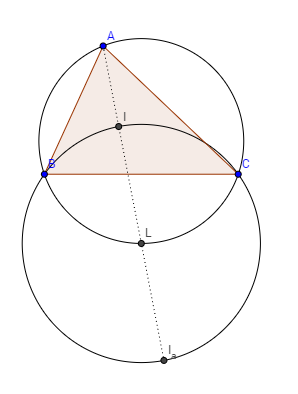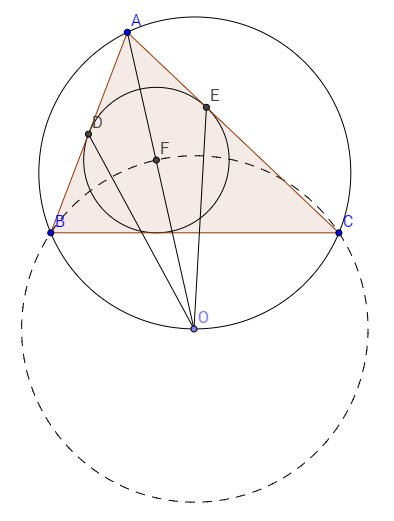A Nice Problem Trivialized By a Single Lemma!
(CGMO 2012) The incircle of a triangle ABC is tangent to sides AB and AC at D and E respectively, and O is the circumcenter of triangle BCI where \(I\) denotes the incenter of \(\bigtriangleup ABC\). Prove that \(\angle ODB = \angle OEC \)
We will first prove this lemma.
Let be a triangle with incenter , A-excenter , and denote the midpoint of arc to be , then points are concyclic with as the circle center.
(We will denote angle , , , as and , respectively.)
Also note that

Proof: First notice that is the intersection of the angle bisector of and perpendicular bisector of .
First we prove that .
Since the perpendicular of to is the perpendicular bisector of , we know that .
Because are angle bisectors, we know that and . By Exterior Angle Theorem, we know that . If we prove that we have proved the segments are equal.
Notice that because they substend the same arc. Therefore this implies that . Thus, by isosceles triangles we get that . This tells us that are concyclic with as a center.
Now, we must prove that also lies on this circle.
Recall that the is the intersection of the exterior-angle bisectors of and . Therefore if you extend and and construct the angle bisector of the exterior angle, it intersects at .
Denote as a point on ray past B.
By Exterior Angle Theorem, we have that .
Since is the angle bisector, we have that . Since , this implies that .
We proved that .
Again by exterior angle theorem, since , we have that which implies that is isoscles which implies that . Therefore must be concyclic with because it's radius to the center, , is the same. Therefore, we have proved the lemma.
Okay good. Now let's have fun.

Restatement: The incircle of a triangle ABC is tangent to sides AB and AC at D and E respectively, and O is the circumcenter of triangle BCF where denotes the incenter of . Prove that
By the lemma, we know that the circumcenter, , of is actually the midpoint of arc BC of the circumcircle of .
To prove , it suffices to prove that .
Since is on the angle bisector, we know that . We also know that because they are both tangents to the incircle. Additionally, and share side . Therefore, by , we have that .
This implies that and we are done.
Easy Math Editor
This discussion board is a place to discuss our Daily Challenges and the math and science related to those challenges. Explanations are more than just a solution — they should explain the steps and thinking strategies that you used to obtain the solution. Comments should further the discussion of math and science.
When posting on Brilliant:
*italics*or_italics_**bold**or__bold__paragraph 1
paragraph 2
[example link](https://brilliant.org)> This is a quote# I indented these lines # 4 spaces, and now they show # up as a code block. print "hello world"\(...\)or\[...\]to ensure proper formatting.2 \times 32^{34}a_{i-1}\frac{2}{3}\sqrt{2}\sum_{i=1}^3\sin \theta\boxed{123}Comments
First, let's clarify that point I and point F are the one and the same, which is the incenter of triangle ABC. It seems to me that it's immediately obvious that the quadrilateral AEOD is a kite, so that angles ∠ODA = ∠OEA, and therefore angles ∠ODB = ∠OEC? Am I missing something here?
Log in to reply
It is true that AEOD is a kite, but can you prove it?
Log in to reply
If, given two points on a circle, the tangents through are drawn so that they intersect at a 3rd point, the distances from the 3rd point to the first two points are the same. Any point on the line that passes through this 3rd point and the center of the circle forms the 4th point of the kite, by reason of symmetry.
Log in to reply
Yes...that works. But note both arguments rely on the fact that O lies on the angle bisector of A, and that was the main concept I was trying to convey.
Log in to reply
I think by using the Lemma you've discussed, a harder geometry problem probably can be devised. Let me think on it for a while on how that can be done.
Log in to reply
I agree. Please do so :)